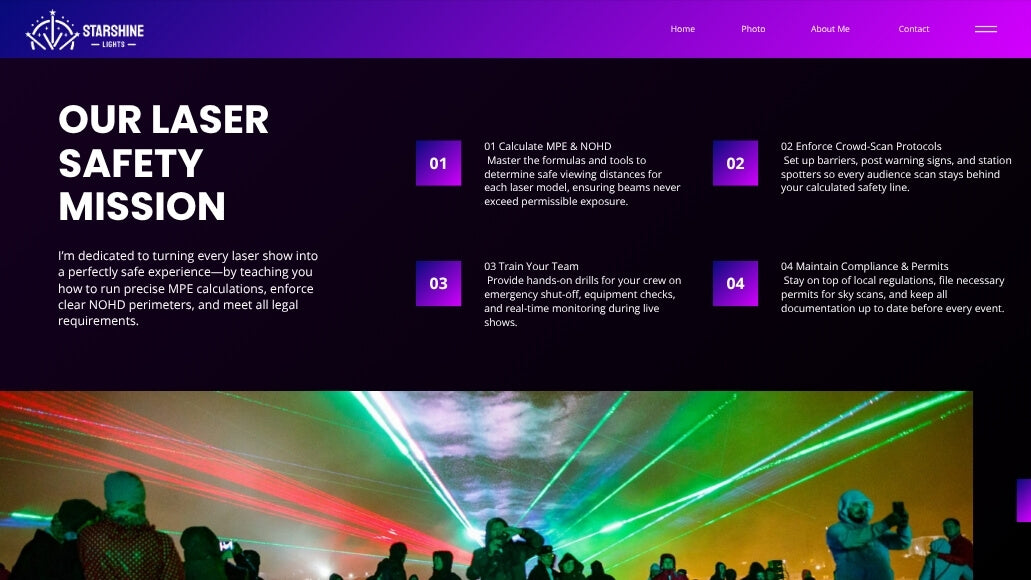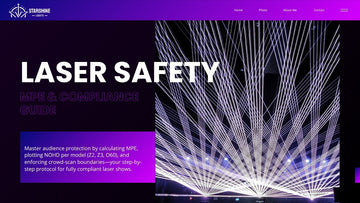Calculating Laser Safety: MPE, Crowd-Scans & Compliance
Keeping your audience safe tops my list whenever I set up a laser projector show. Dive into this guide to learn how to calculate MPE (Maximum Permissible Exposure), run crowd-scan checks, and stay compliant—plus see which Starshine models fit your needs and exactly how far back your viewers must stand.

What Is MPE and Why Your Laser Projector Needs It
MPE defines the maximum laser exposure your audience’s eyes can handle without harm. Ignoring MPE risks injuries and legal headaches. In plain terms:
Power Matters: A 15W beam burns farther than an 8W beam.
Divergence Counts: Narrow beams focus energy; wide beams spread it out.
Exposure Time: The longer you scan over the crowd, the stricter your limits.
By mastering MPE, you transform your laser light projector setup from risky to rock-solid safe.
How to Calculate MPE & NOHD for Your Laser Projector Show
Follow these steps to determine your safety perimeter:
Gather Specs
Power (e.g., 8W, 10W, 15W, 60W)—your model will report this in its datasheet.
Beam divergence (degrees) from the spec sheet.
Use a Simplified MPE Formula
MPE ∝ Power / (Divergence² × Exposure^0.75).
I plug numbers into an online calculator or a spreadsheet.
Compute NOHD (Nominal Ocular Hazard Distance)
NOHD tells you the minimum distance viewers must stay behind.
Plan Crowd-Scans
Low-power audience scans require your NOHD line to lie behind the barrier.
Post clear “Lasers in Use” signs and station trained spotters at entry points.
By running these calculations, I ensure my outdoor laser lights never stray into unsafe zones.

Compare & Choose: Z2 vs. Z1 vs. Z3 vs. O60 Laser Projector Models
| Model | Power | Safe Distance (NOHD) | Best Use Case |
|---|---|---|---|
| Z2 8W Laser Light | 8W | ~20 m | Home shows, small DJ sets |
| Z1 10W App Laser Light | 10W | ~25 m | Club gigs, RGB effects |
| Z3 15W Laser Light | 15W | ~30 m | Medium venues, smoke-enhanced shows |
| O60 60W 3D Laser Projector | 60W | ~60 m | Large outdoor festivals |
Compare: Z2 vs. Z1 – Z1 adds app control and full-color rgb laser effects plus a slightly longer NOHD.
Versus: Z3 vs. O60 – Z3 gives agile patterns, O60 floods huge areas with high-power beams and demands the largest safety perimeter.
Buy Guide: Start with Z2 for a laser light show projector at home, then upgrade to O60 for outdoor laser light show events.

Quick Setup & Compliance Checklist for Your Laser Projector
Position: Mount your projector on a stable truss or stand at least 2 meters above the floor.
Beam Path: Aim beams above head height when scanning crowds.
Safety Perimeter: Mark your calculated NOHD lines—20m for Z2, 25m for Z1, 30m for Z3, 60m for O60—and keep viewers behind them.
Signage: Use laser warning labels at all entry points.
Training: I brief my team on emergency shut-off procedures.
Permit: Check local rules—some areas require a laser show machine permit for sky laser scans.
Pro Tips & Info for a Killer Laser Projector Show
Programmable Laser Lights: Use your controller’s timeline to sync beams with dj laser lights and laser light machine cues.
Contrast Tricks: Pair your laser projector with LED wash fixtures like led projector lights outdoor for depth.
Wireless vs. Wired: A wireless DMX link hides cables on an outdoor stage; wired reduces latency.
Final Thoughts & Next Steps
I’ve laid out my go-to MPE formulas, NOHD checks, and a compare of four top laser projector models—complete with exact safety distances. Now it’s your turn: pick the unit that matches your venue and style, run your safety calcs, and light up the sky—safely. Enjoy site-wide free delivery, and stay tuned: I’m opening warehouses in Greece and the Netherlands soon and scouting local agents there. Choose wisely, comply fully, and make your next laser show unforgettable!



























